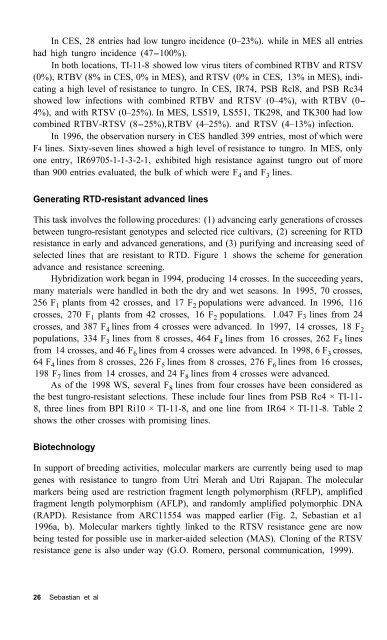Rice tungro disease management - IRRI books - International Rice ...
Rice tungro disease management - IRRI books - International Rice ...
Rice tungro disease management - IRRI books - International Rice ...
You also want an ePaper? Increase the reach of your titles
YUMPU automatically turns print PDFs into web optimized ePapers that Google loves.
In CES, 28 entries had low <strong>tungro</strong> incidence (0–23%). while in MES all entrieshad high <strong>tungro</strong> incidence (47-100%).In both locations, TI-11-8 showed low virus titers of combined RTBV and RTSV(0%), RTBV (8% in CES, 0% in MES), and RTSV (0% in CES, 13% in MES), indicatinga high level of resistance to <strong>tungro</strong>. In CES, IR74, PSB Rcl8, and PSB Rc34showed low infections with combined RTBV and RTSV (0–4%), with RTBV (0-4%), and with RTSV (0–25%). In MES, LS519, LS551, TK298, and TK300 had lowcombined RTBV-RTSV (8-25%), RTBV (4–25%). and RTSV (4–13%) infection.In 1996, the observation nursery in CES handled 399 entries, most of which wereF4 lines. Sixty-seven lines showed a high level of resistance to <strong>tungro</strong>. In MES, onlyone entry, IR69705-1-1-3-2-1, exhibited high resistance against <strong>tungro</strong> out of morethan 900 entries evaluated, the bulk of which were F 4 and F 3 lines.Generating RTD-resistant advanced linesThis task involves the following procedures: (1) advancing early generations of crossesbetween <strong>tungro</strong>-resistant genotypes and selected rice cultivars, (2) screening for RTDresistance in early and advanced generations, and (3) purifying and increasing seed ofselected lines that are resistant to RTD. Figure 1 shows the scheme for generationadvance and resistance screening.Hybridization work began in 1994, producing 14 crosses. In the succeeding years,many materials were handled in both the dry and wet seasons. In 1995, 70 crosses,256 F 1 plants from 42 crosses, and 17 F 2 populations were advanced. In 1996, 116crosses, 270 F 1 plants from 42 crosses, 16 F 2 populations. 1.047 F 3 lines from 24crosses, and 387 F 4 lines from 4 crosses were advanced. In 1997, 14 crosses, 18 F 2populations, 334 F 3 lines from 8 crosses, 464 F 4 lines from 16 crosses, 262 F 5 linesfrom 14 crosses, and 46 F 6 lines from 4 crosses were advanced. In 1998, 6 F 3 crosses,64 F 4 lines from 8 crosses, 226 F 5 lines from 8 crosses, 276 F 6 lines from 16 crosses,198 F 7 lines from 14 crosses, and 24 F 8 lines from 4 crosses were advanced.As of the 1998 WS, several F 8 lines from four crosses have been considered asthe best <strong>tungro</strong>-resistant selections. These include four lines from PSB Rc4 × TI-11-8, three lines from BPI Ri10 × TI-11-8, and one line from IR64 × TI-11-8. Table 2shows the other crosses with promising lines.BiotechnologyIn support of breeding activities, molecular markers are currently being used to mapgenes with resistance to <strong>tungro</strong> from Utri Merah and Utri Rajapan. The molecularmarkers being used are restriction fragment length polymorphism (RFLP), amplifiedfragment length polymorphism (AFLP), and randomly amplified polymorphic DNA(RAPD). Resistance from ARC11554 was mapped earlier (Fig. 2, Sebastian et a11996a, b). Molecular markers tightly linked to the RTSV resistance gene are nowbeing tested for possible use in marker-aided selection (MAS). Cloning of the RTSVresistance gene is also under way (G.O. Romero, personal communication, 1999).26 Sebastian et al
















